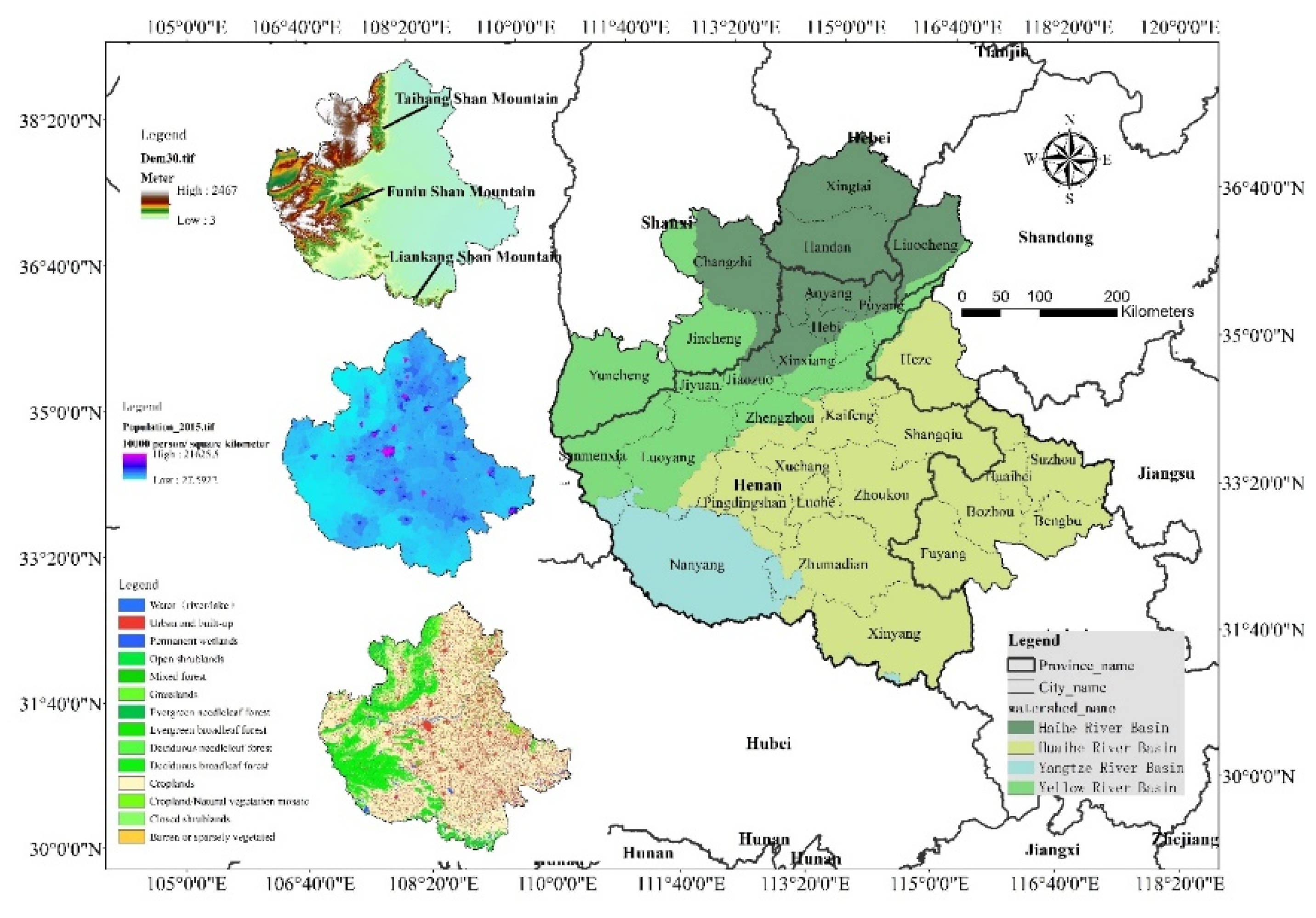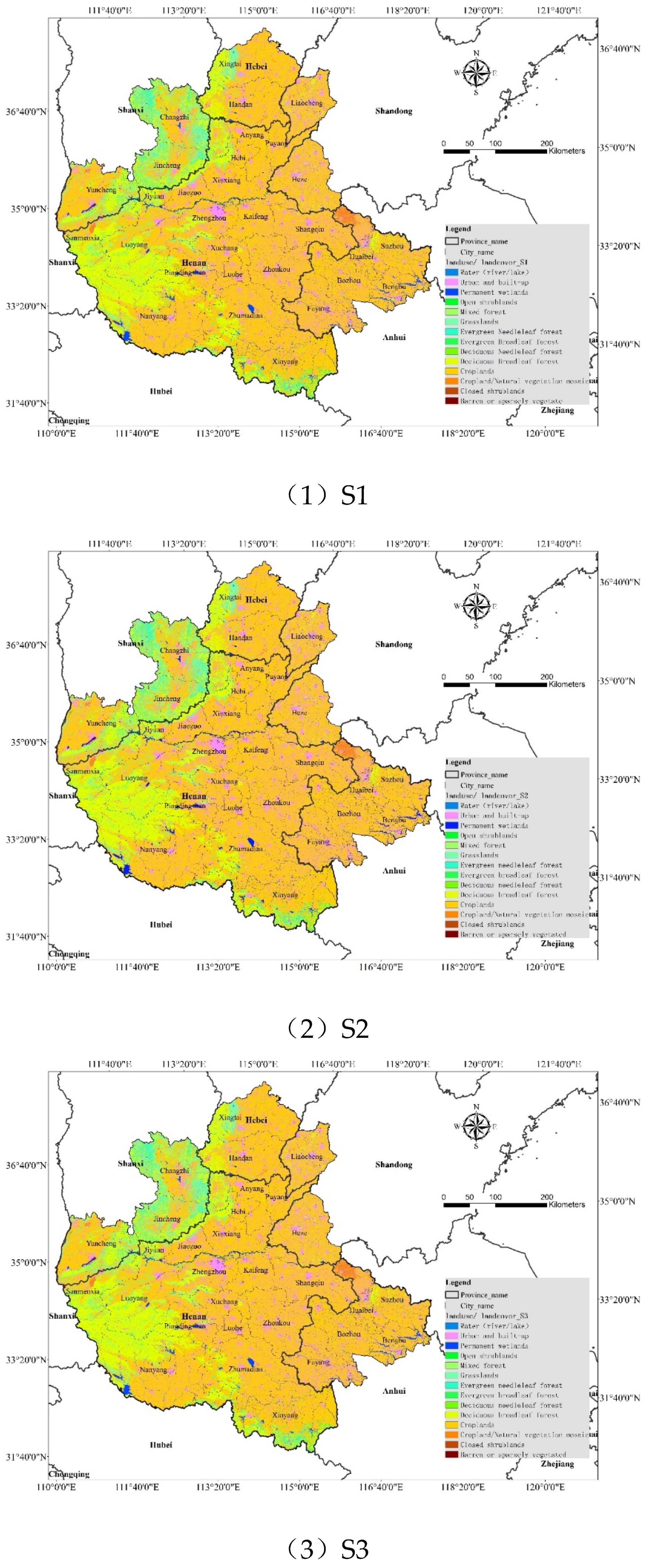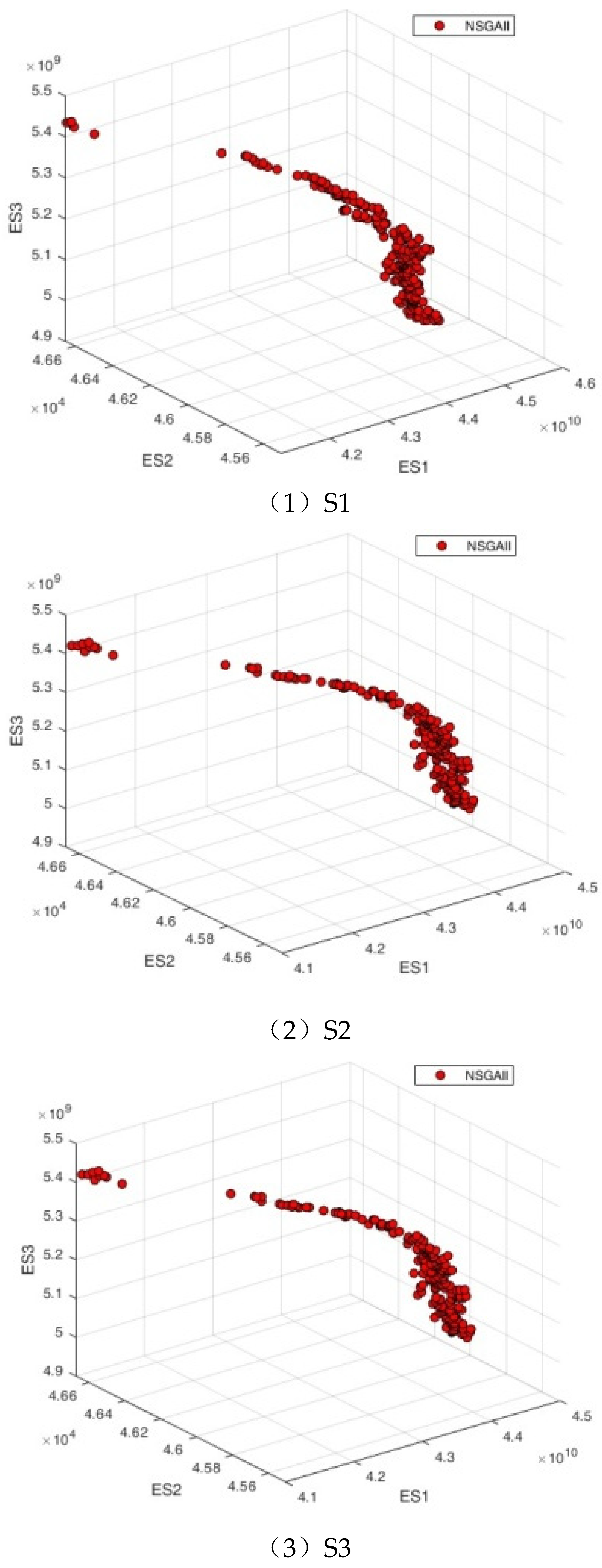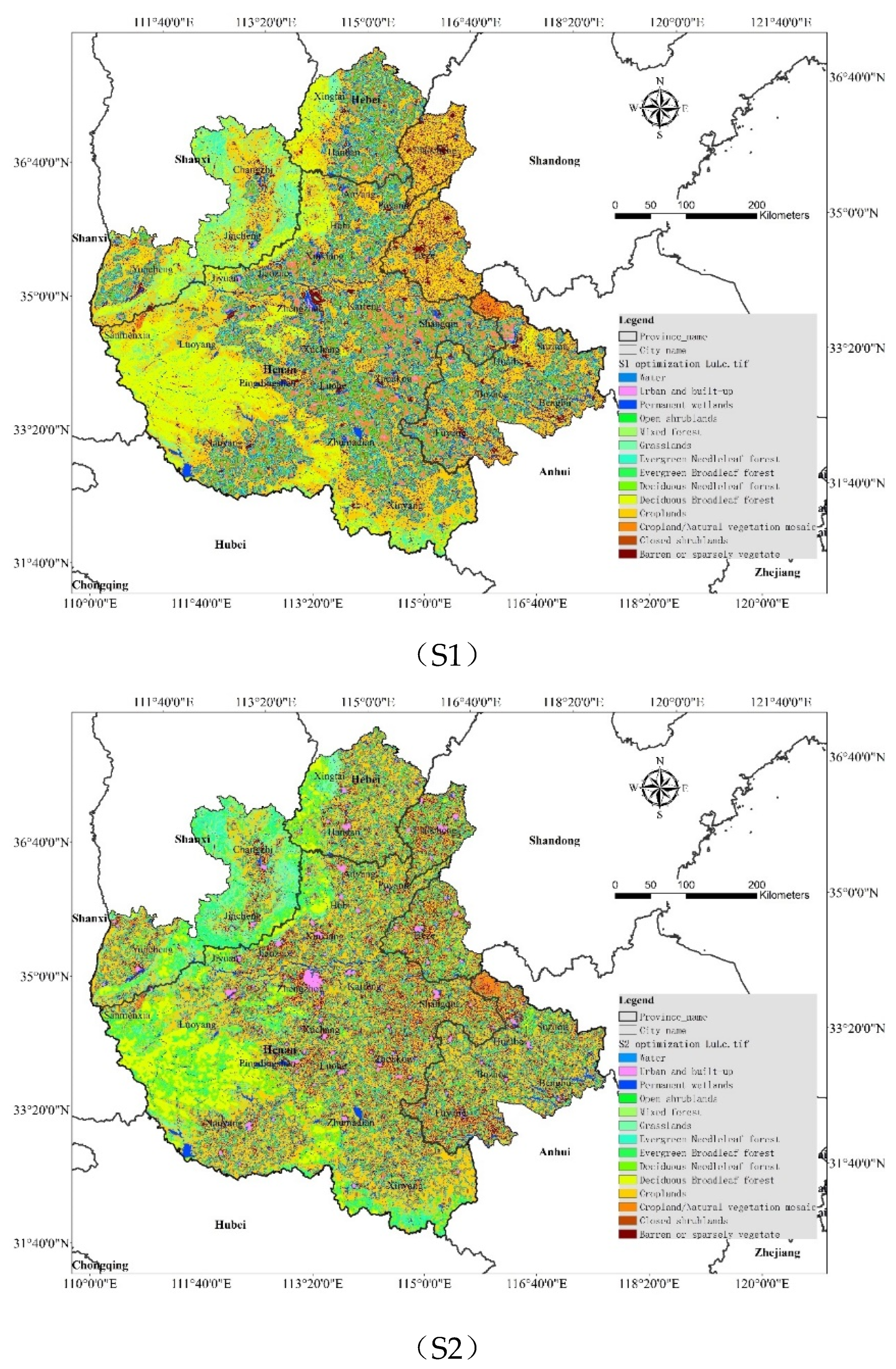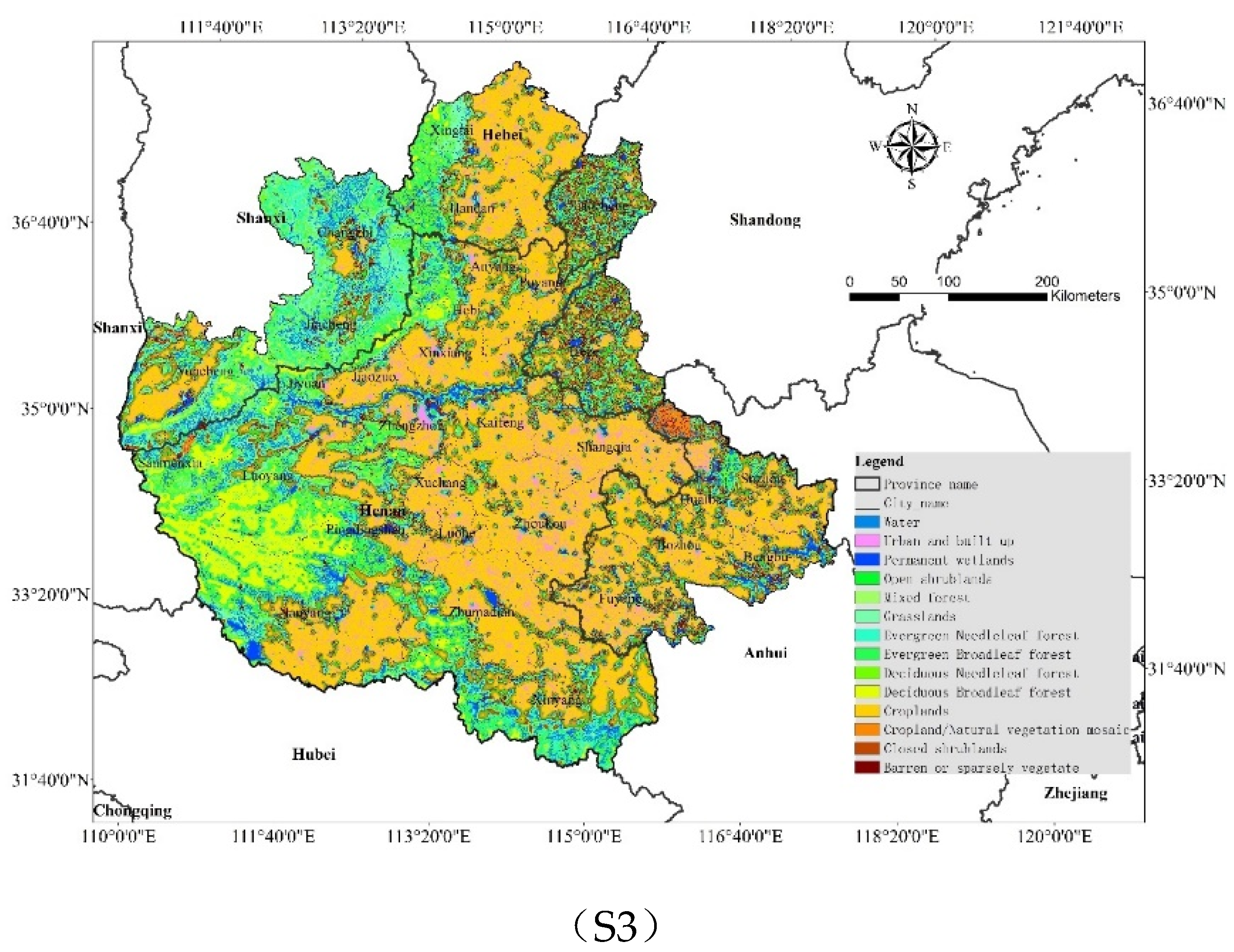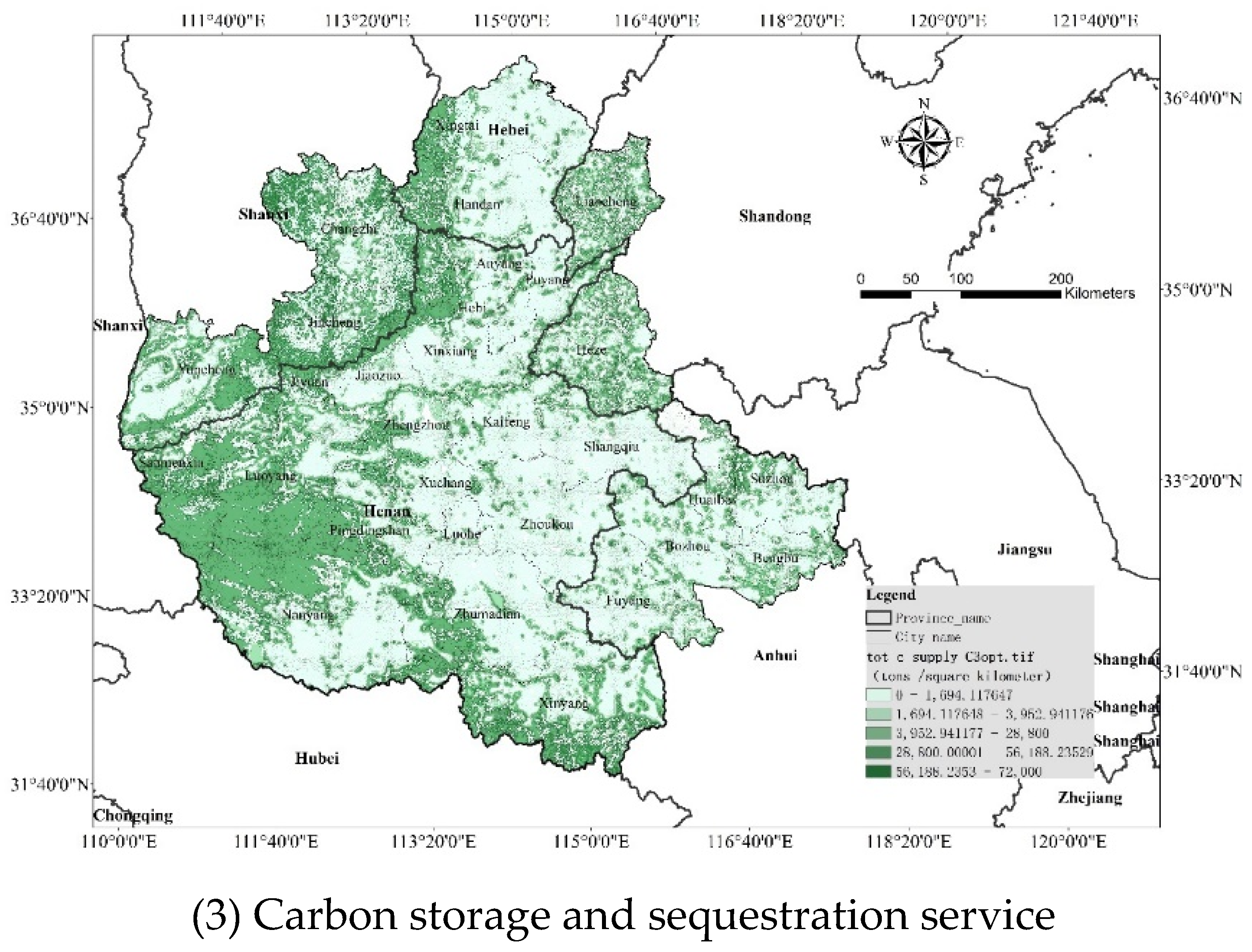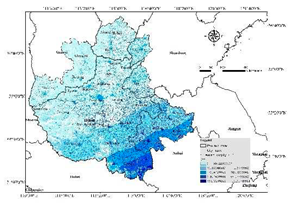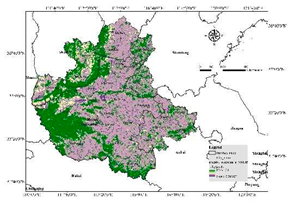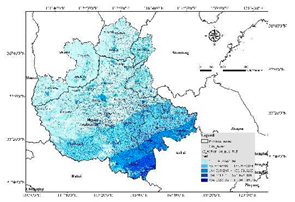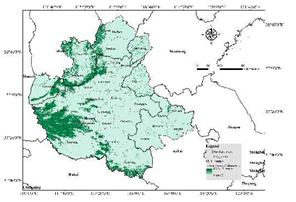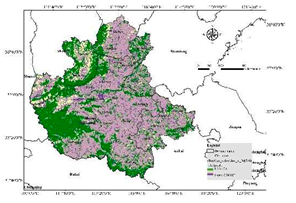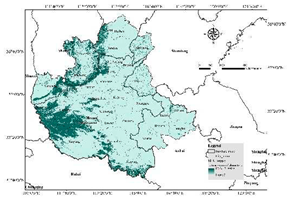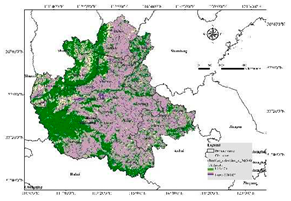1. Introduction
The ecosystem provides various service functions (supply, regulation, support, and cultural services) in terms of natural resources and living environments for humans, and humans provide demand and consumption for its products and services [
1,
2]. Human society depends on ecosystem services to survive, and both supply and demand constitute a dynamic process of ecosystem services flowing from the natural ecosystem to the human social system [
3]. Therefore, ecosystem services emphasise the core of human utilisation [
4]. Some studies have examined ecosystem services’ supply potential, demand, and supply and demand matching [
5,
6]. They have found that only when the supply of ecosystem services matches people’s demand can the management of ecosystem services play a large role in social and economic development [
7,
8,
9,
10].
Pareto frontiers have been widely used in determining the goals of ecosystem service optimisation, which aims to pursue the Pareto optimal solution for ecosystem service [
10,
11]. Aiming for a Pareto optimal solution, the idea of ecosystem service optimisation is as follows: A series of land use situations under different management objectives of protection and development are set up, and the optimal ecosystem service combination (Pareto curve) and corresponding land use planning scheme are obtained using the optimisation model. Then, land use optimisation under the guidance of ecosystem services is conducted, and the land use type transformation is implemented quantitatively and systematically to seek the optimal land use pattern under an optimal ecosystem service [
12,
13,
14].
Regarding method application, the optimisation of ecosystem services is often realised by integrating biophysical and mathematical optimisation models [
15]. Among them, InVEST (Integrated Valuation of Ecosystem Services and Tradeoffs) is the commonly used biophysical model, and the multi-objective spatial optimisation algorithm Non-dominated Sorting Genetic Algorithm-II (NSGA-II) is the most commonly used mathematical model. For example, Lautenbach et al. integrated the SWAT and NSGA-II models to study the effects of different crop planting patterns on food supply, water yield, biofuel and water purification, obtaining the optimal set of ecosystem services [
16,
17]. Hu et al. developed the SAORES ecosystem services optimisation model, which integrated the InVEST and NSGA-II models, to study the impact of land use structure change on water yield, soil conservation, carbon storage, and food production. They then optimised the ecosystem services with trade-off relations, achieving good optimisation results [
17].
The NSGA-II algorithm is the most efficient calculation method with a multi-objective function, which is mainly used to simulate a series of land use schemes and obtain the Pareto optimal set of ecosystem services. With the Pareto optimal set as the primary data, Python language or statistical software is used to complete data visualisation, drawing the Pareto curve and displaying the optimisation results [
10]. Currently, the NSGA-II algorithm is mature for applying ecosystem service optimisation. However, it still has the following deficiencies: When optimising the setting of constraint conditions, more attention is paid to the possible spatial layout of land use, but less attention is paid to the constraint conditions of ecosystem services. It is also necessary to set the threshold value of ecosystem services in combination with the supply-demand relationship and matching characteristics and improve the service constraints to improve the accuracy and applicability of the optimisation results.
As one of the urban agglomerations in Central and Western China that are severely constrained by resources and environment, rapid urbanisation and population agglomeration have caused tremendous pressure on the regional ecological environment, and problems such as water environment pollution and water resource shortage in some areas have become increasingly serious [
18]. Integrating the demand for ecosystem services into space management, optimising and adjusting the supply structure of ecosystem services, and matching the supply and demand of ecosystem services are the primary issues to be considered in solving the ecological dilemma of the Central Plains Urban Agglomeration.
Taking the Central Plains Urban Agglomeration as an example, this project explores the optimisation of urban agglomeration ecosystem services based on supply and demand matching, which enriches the research content related to the optimisation of urban agglomeration ecosystem services and helps people to establish ‘large region’ and ‘environment’ perspectives, providing theoretical guidance for the coordinated natural, social, and economic development between regions.
2. Materials and Methods
2.1. Study area
The population and economic activities of the Central Plains Urban Agglomeration are highly intensive, and the regional ecological resources are rich. However, the spatial distribution of socioeconomic and ecological resources is very uneven. The ecological resources are mainly distributed in the ecological space composed of the Liankang Mountains, Funiu Mountains, Taihang Mountains, the ecological corridors along the middle line of the South-to-North Water Diversion Project, and the middle and lower reaches of the Yellow River. Socioeconomic activities are mainly concentrated in the urban space in the central and eastern regions [
19].
With the continuous intensive development of urban agglomerations, the flow of ecosystem services is more frequent and concentrated, and the difference between the supply and demand of ecosystem services between regions is gradually increasing. The degradation of the regional ecosystem service’s supply function, water resource shortages, water environment pollution, and increased carbon emission have become major limiting factors for the healthy and sustainable development of the Central Plains Urban Agglomeration [
18]. In this context, it is vital to realise ecosystem service management and optimise ecosystem services to match their supply and demand. This research can provide spatial guidance for realising the objectives of ecosystem service management.
Figure 1.
Study area location and land use type, topography, and population distribution map.
Figure 1.
Study area location and land use type, topography, and population distribution map.
2.2. Materials
The land use data used in this paper is based on the Landsat remote sensing image of the United States as the primary information source and the national scale multi-period land use/land cover thematic database of China constructed by artificial visual interpretation. This paper uses land use data for the study area from 2010, 2015, and 2020. Spatial distribution data of China’s altitude (digital elevation model) are derived from the Shuttle Radar Topography Mission (SRTM) data of the US Space Shuttle Endeavour and based on the 30 m provincial data generated in the recent SRTM V4.1 update. The data were projected using the WGS84 ellipsoid. Meteorological observation data were obtained from the China Meteorological Data network (
http://data.cma.cn/). In this study, potential evaporation, daily precipitation, and other meteorological data from meteorological stations in the Central Plains Urban Agglomeration in 2015 were selected and processed to obtain the meteorological data for the study area. Soil Data China Soil Data Set with a resolution of 1000 m. The spatial population distribution data refers to the statistical population data of districts and counties. Considering the population distribution influencing factors such as land use type, night light brightness, and residential density, the multi-year population distribution grid data was prepared through spatialisation with a spatial resolution of 1000 m. The above remote sensing and spatial data can be accessed at
www.resdc.cn.
The reference standards for water quota and water purification requirements used in this study refer to the environmental capacity issued by local governments in the study area [
20]. Per capita carbon emissions data came from the Intergovernmental Panel on Climate Change [
21]. The biophysical parameters involved in the InVEST model are based on the data recommended in the model operation manual [
22]. Based on the study area’s ecosystem characteristics, climatic conditions, soil geological conditions, and vegetation type characteristics, and supported by relevant literature and expert consultation information, the data were obtained through merging and statistics [
23,
24].
2.3. Methods
Based on multi-source remote sensing data, this paper uses the “water production” (equation 1), “water purification” (equation 2), and “carbon storage and sequestration” (equation 3) sub-modules of the InVEST model. The quantity and spatial distribution of the water supply, water purification, and carbon storage and sequestration services in the Central Plains Urban Agglomeration ecosystem were quantitatively evaluated [
22]. The ArcGIS platform’s spatial analysis function was used to quantitatively evaluate the spatial characteristics of ecosystem service supply and demand in the study area. Freshwater demand service refers to the environmental capacity issued by each local government in the study area according to the reference standards of various urban and rural water consumption quotas. Carbon storage and sequestration service demand is mainly calculated based on carbon emission data per capita and population density distribution in energy statistics (equation 4).
2.3.1. Water supply service
where Yxj is the annual water quantity of land cover type j in grid x in mm, AETxj is the actual evapotranspiration of land cover type j in grid x in mm, and Px is the precipitation in grid x in mm.
2.3.2. Water purification (nitrogen [N] retention) service
where ALVx is the adjusted N output of grid x, HSSx is the hydrological sensitivity score of grid x, and polx is the N output coefficient of grid x. After obtaining the N output, the purification amount is calculated according to the removal efficiency of N for each land use or land cover type.
2.3.3. Carbon storage and sequestration service
where is the total carbon storage, Cbellow is the carbon storage of underground biomass, Cabove is the carbon storage of the aboveground biomass, Csoil is the carbon storage of the soil carbon pool, and Cdead is the dead organic carbon storage.
The demand for carbon storage and sequestration service:
where C
e is the carbon emissions from human social and economic activities (i.e., the carbon source),
p(
x) is the spatial population density of grid
x,
is the carbon emissions per capita in grid
x, and
X is the total number of grids in the study area.
2.3.4. Scenario analysis setting
Based on the data for 2015, this study set three scenarios: planning, development, and protection. Under different scenarios, the land use/land cover (
Table 1,
Figure 2) is as follows:
Planning scenario (S1): To conduct urbanisation construction according to the “Central Plains Urban Agglomeration Development Plan 2016-2020”, the land for urban expansion is 33,821 ha, mainly from adjacent open shrublands, closed shrublands, grasslands, croplands, mixed cropland/natural vegetation areas, and barren or sparsely vegetated areas.
Development scenario (S2): According to the evolution trend from 2010 to 2020, urban and built-up areas rapidly expanded to the periphery with an increase of 209,237 ha. Urban expansion land mainly came from adjacent open shrublands, closed shrublands, grasslands, croplands, mixed cropland/natural vegetation areas, and barren or sparsely vegetated areas.
Protection scenario (S3): According to the target of the ecological space scale in 2010, permanent wetlands, including woodland, grassland, and wetland, will expand the ecological land, shrink the construction land and farmland, and implement the ecological protection strategy to increase grassland, woodland, and wetland by 194,855 ha.
2.3.5. Ecosystem service optimisation
This study used the Matlab software platform and the NSGA-II optimisation model to obtain a Pareto optimal solution set. The specific steps were as follows:
First, determine the initial solution. Based on the land use data at the end of 2015, this study evaluated water supply, water purification (N retention), and carbon sequestration ecosystem services in the study area under three scenarios as the initial solution to ecosystem service optimisation.
Second, the Pareto optimal solution set was obtained by running the optimisation model (NSGA-II). The mathematical description of optimisation is shown in
Table 2. The optimisation constraints included structural and service constraints. Among them, structural constraint refers to the area and layout requirements of various types of land use, and service constraint refers to different ecosystem services needing to meet the minimum demand for the ecosystem services of social and economic development. They included:
(1) Land area constraints: according to the mandatory requirements of “three districts and three lines” in national territorial space planning, the constraint conditions for farmland area selected in this study were not less than 110 million mu (73,334 km2), and the constraint conditions of ecological space (grassland, forest, shrub, wetland, and water body) were not less than 16,835.70 km2.
(2) Land layout constraints: all land layout conditions consider factors such as slope, terrain, soil and hydrology. Farmland with a slope >20 degrees should be returned to forest and grassland. To ensure the integrity of the ecological spatial structure, illegal industrial, mining, construction, and other lands should be relocated, and ecological land should be reserved in the river corridors of the southern Yellow River and the southern Huaihe River, and the ecological corridors of the Taihang Mountain, Funiu Mountain and Liankang Mountain.
(3) Service constraints: considering the evaluation results of ecosystem service supply and demand in the study area and its natural socioeconomic characteristics, the study area’s water supply service should be ≥40 billion cubic metres, water purification (N retention) service should be ≥45,000 tons, and carbon storage and sequestration service should be ≥1 billion tons to meet the ecosystem constraints.
Finally, the above optimal solutions were screened through expert consultation and other means, and the optimal solutions with practical application potential and corresponding land use structure schemes were retained, laying the foundation for optimising the land use structure of ecological space in the next step.
2.3.6. Methods of land use/land cover optimisation and adjustment
First, the pre-optimisation land cover/use map (i.e. current land cover/use map) and the optimised land cover/use map were compared, and the area attributes and spatial positions of different land cover/use types were extracted. The combined conversion requirements for land cover/use between them were calculated. Then, the expert knowledge method was adopted to select the suitable land use combination and form the ecological spatial structure optimisation scheme. Considering the influence of the international situation on food security in the present and future, this study, combined with the function positioning of the central region as a grain production area, determined the farmland protection priority, ecological land protection as far as possible, the development of construction land stock, the minimum increase for construction land and other principles, and established the optimal layout of land use types.
In specific operations, we optimised the conversion of the land cover type according to the principles of preferential conversion of land type similarity, preferential conversion of the close distance, and preferential conversion of land type with low difficulty. The conversion process and results mainly used the InVEST model Scenario Generator module. The spatial layout was conducted through outward expansion from the target land class. The deciduous broadleaf forest optimisation adjustment order was deciduous needleleaf forest, evergreen broadleaf forest, and evergreen needleleaf forest. The croplands optimisation adjustment order was water, evergreen needleleaf forest, mixed forest, closed shrublands, open shrublands, grasslands and permanent wetlands, and mixed cropland/natural vegetation. The urban and built-up optimisation adjusted the order to mixed cropland/natural vegetation.
3. Results
3.1. Initial value of the current supply and demand situation of ecosystem services
The results showed (
Table 3 and
Table 4) that in terms of supply, S1 had 33.60 billion cubic metres of water supply, 57,600 tons of water purification (N retention), and 2.94 billion tons of carbon sequestration; S2 had 34.10 billion cubic metres of water supply, 57,200 tons of water purification (N retention), and 2.94 billion tons of carbon sequestration; S3 had 33.40 billion cubic metres of water supply, 57,400 tons of water purification (N retention), and 3.04 billion tons of carbon sequestration. In terms of demand, the water supply service demand in different scenarios was 52.762 (S1), 53.573 (S2), and 52.330 (S3) billion cubic metres; the water purification (N retention) service demand was 114,100 tons; and the carbon storage and sequestration service demand was 1.072, 1.000, and 1.004 million tons, respectively.
The analysis showed that the total annual supply of the water supply service was less than the total freshwater demand under the three scenarios. The total supply of the water purification (N retention) service was smaller than its total demand. The total supply of the carbon storage and sequestration service was greater than its total demand. Regarding spatial distribution (
Table 5), the supply pattern of the same ecosystem services under different scenarios was similar. The water supply service has a pattern of less in the north and more in the south, and the water supply service per unit area of land gradually increased from north to south. Carbon storage and sequestration service areas are mainly located in Taihang and Funiu Mountains in the west and Liankang Mountains in the south. The water purification (N retention) service had a pattern of high peripheral and low central farmland.
Since the study area is the location of the middle route of the South-to-North Water Diversion project, the water supply service of the Central Plains Urban Agglomeration has additional resources, and the future water supply service output of the local natural ecosystem of ≥40 billion cubic metres can meet the demand. Since the nitrogen emissions of Central Plains Urban Agglomeration (using the main province of Henan as an example) have exceeded the nitrogen water environmental capacity of the study area, urban and rural sewage treatment projects in the study area have been included in the national and local government work plan. The future water purification (N retention) service output of the local natural ecosystem of ≥45,000 tons can meet the demand. The total supply of carbon storage and sequestration service is greater than its total demand, which can be met by keeping the carbon storage and sequestration service up to 1 billion tons.
3.2. The Pareto optimal solution for ecosystem services
In the Matlab platform, the NSGA-II optimisation model was used to obtain water supply (ES1), water purification (N retention) (ES2), and carbon storage and sequestration (ES3) under different scenarios to determine the three-objective Pareto optimal solution set between services. The results showed 199, 197, and 197 optimal solutions for the water supply (ES1), water purification (N retention; ES2), and carbon storage and sequestration (ES3) services under S1, S2, and S3, respectively (
Figure 3). Based on the Pareto curve’s optimal solution screening method, combined with the urgency of different ecosystem services in the study area, the potential of alternative resources of ecosystem services, and the surplus/shortage of total ecosystem services, we determined the three-objective Pareto optimal solution between water supply, water purification (N retention), and carbon storage and sequestration services under S1 (442.82, 4.62, and 54.27, respectively), S2 (423.43, 4.62, and 54.06, respectively), and S3 (412.32, 4.66, and 54.20, respectively).
Under this optimisation goal, to achieve Pareto optimality of ecosystem services, the water supply, water purification (N retention), and carbon storage and sequestration services must be optimised simultaneously, and ecosystem services must be optimised and adjusted. Under S1, the water supply service needs to increase by 86.820 to 11.211 billion cubic metres, the water purification (N retention) service needs to decrease by 1.14 to 11,700 tons, and the carbon storage and sequestration service needs to decrease by 2.020 to 2.487 billion tons. Under S2, the water supply service needs to increase by 8.243 to 10.666 billion cubic metres, the water purification (N retention) service needs to decrease by 1.130 to 1.100 million tons, and the carbon storage and sequestration service needs to decrease by 2.033 to 2.466 billion tons. Under S3, the water supply service needs to increase by 7.832 to 11.437 billion cubic metres, the water purification (N retention) service needs to decrease by 1.16 to 10,800 tons, and the carbon storage and sequestration service needs to decrease by 1.922 to 2.380 billion tons.
3.3. Land use optimisation based on ecosystem services
3.3.1. Land use area optimisation
In this study, the land use/land cover in the study area was assumed to be a single type. The ecosystem service quantity of a single land use type in the study area was obtained using the InVEST model and the corresponding model’s input coefficient, which was the conversion coefficient between land use types to provide data relations for land optimisation and adjustment based on ecosystem service. Among the results (
Table 6), the largest land use type of the water supply service was water, and the conversion coefficient for this ecosystem service was 49.13 billion cubic metres/km
2. The highest conversion coefficient for the water purification (N retention) service was 2.75 million tons/km
2 for croplands. The smallest carbon storage and sequestration services were for water, urban and built-up, and barren or sparsely vegetated areas with zero carbon storage and sequestration service.
Based on the land use conversion coefficient, this study used the Matlab software platform and NSGA-II optimisation model to obtain the land use type area corresponding to the Pareto optimal solution for ecosystem services under different scenarios. To achieve the objective of ecosystem service optimisation in the study area (
Table 7), deciduous broadleaf forests, croplands, and urban and built-up areas were the diversion sides in land conversion (
Figure 4). Under S1, deciduous broadleaf forests, croplands, and urban and built-up areas must transfer 28,187, 84,919, and 27151 km
2, respectively. Under S2, deciduous broadleaf forests, croplands, and urban and built-up areas must transfer 28,228, 82,760, and 28,924 km
2, respectively. Under S3, deciduous broadleaf forests, croplands, and urban and built-up areas require 28,174, 83,121, and 25,244 km
2, respectively.
3.3.2. Scenario optimisation selection based on land use pattern
As shown in
Table 7, to achieve the goal of ecosystem service optimisation in the study area, the deciduous broadleaf forest in the mountainous area, the croplands in the central area, and the urban and built-up areas all decreased in different scenarios. In contrast, water, evergreen needleleaf forests, evergreen broadleaf forests, deciduous needleleaf forests, mixed forests, closed shrublands, open shrublands, grasslands, permanent wetlands, mixed cropland/natural vegetation, and barren or sparsely vegetated areas were the primary land importers and increased in area accordingly. The optimised land cover/land use structure under different scenarios is shown in
Figure 5: The central and eastern regions were mainly cropland and urban and built-up areas. The mountains to the west and south were mainly evergreen needleleaf forests, evergreen broadleaf forests, deciduous needleleaf forests, mixed forests, closed shrublands, open shrublands, and grasslands.
Regarding the optimised planning (S1; 33,821 ha) and development (S2; 209,237 ha) scenarios, open shrublands, closed shrublands, grasslands, croplands, mixed cropland/natural vegetation adjacent to urban and built-up and barren or sparsely vegetated areas were mainly converted to urban and built-up areas (S1: 33,821 ha; S2: 209,237 ha), leading to severe fragmentation of land use structure in the middle of S1 and S2 after optimisation, damaging the integrity of the ecosystem in the central region, which may affect ecosystem service processes and functions and reduce the sustainable supply capacity of ecosystem services. In the optimised conservation scenario (S3), water, evergreen needleleaf forests, evergreen broadleaf forests, deciduous needleleaf forests, mixed forests, closed shrublands, open shrublands, grasslands, and permanent wetlands adjacent to 194,855 ha of croplands and urban and built-up areas were converted to evergreen needleleaf forest, evergreen broadleaf forest, deciduous needleleaf forest, mixed forest, closed shrubland, open shrubland, grassland, or permanent wetland. After land use optimisation and adjustment, the ecological land structure of S3 was complete; the ridgelines of Taihang Mountain, Funiu Mountain, and Liankang Mountain in the north, west, and south were more continuous; the river corridor structures of the Yellow River and Huaihe River were more complete; and the croplands in the middle were distributed in concentrated contiguous areas. The land use structure was more consistent with the study area’s ecological protection and urban development vision. Therefore, S3 was selected as the optimal scenario in this study.
3.4. Optimisation of the supply pattern of ecosystem services
The optimised S3 is the optimal scenario in this study. Based on the optimised S3 land use/landcover pattern, this study quantified the ecosystem service supply pattern in the study area and obtained its optimisation results. The results showed (
Figure 6) that after optimisation, the water supply service increased in the central and western parts of the study area, improving the potential of farmland production activities and urban water supply in populated areas in the central part of the study area. After optimisation, the demand zone (negative zone) of the water purification (N retention) service in the central area was reduced, the supply zone of the water purification (N retention) service was connected to the study area and had better connectivity, and the supply and demand zones were more closely combined. After optimisation, the carbon storage and sequestration service supply in the central part of China increased, connecting the eastern and western ecosystem service supply areas. The carbon storage and sequestration service’s supply pattern in the study area was more balanced after optimisation.
4. Discussion
Human society depends on ecosystem services to survive, and humans are the primary users of ecosystem services. Only when the supply of ecosystem services matches people’s demand can the management of ecosystem services play a large role [
1]. Optimising ecosystem service based on demand is the core content of ecosystem service management [
10]. Pareto frontiers have been widely used in determining the objectives of ecosystem service optimisation [
14]. The Pareto curve of ecosystem services (Pareto frontiers) is mathematically represented as a curve in an axis. Each point in the curve (Pareto frontier) represents an optimal combination of solutions, meaning that when an ecosystem service remains in the same constant state, the maximum possible value of other ecosystem services (the area under the curve) is suboptimal; that is, when the solution ES is in the same constant state under this solution set, other ecosystem services still have room for improvement by adjusting the spatial land pattern. In selecting the optimal implementation path, regional land use change can significantly change the pattern and process of the ecosystem, leading to a change in ecosystem service supply [
2,
25,
26]. Therefore, many scholars believe that the optimisation realisation approach is mainly to optimise the land use under the guidance of ecosystem services and seek the potential of improving the supply of ecosystem services by determining the optimal land use pattern under a certain optimal ecosystem service (
Figure 7) [
25,
27,
28]. The optimisation of ecosystem services and the optimisation and adjustment of land use patterns based on it also have clear spatial guidance for optimising the land use planning scheme in the study area [
29]. Based on this, the optimisation of ecosystem services is often used to guide the formulation of regional land planning and natural resource management policies [
13,
30,
31,
32].
Currently, focusing on the supply potential and demand of ecosystem services, some studies have explored how to optimise the supply pattern of ecosystem services and match their demand through land pattern optimisation. Some researchers believe land management based on ecosystem services combines environmental characteristics and social needs. Coupling ecosystem service supply and demand with landscape ecological security patterns is the basis for optimising regional ecological spatial layout [
11,
16,
17,
33]. It also provides important opportunities and options for achieving global sustainable development goals [
25,
34]. Yue et al. took Guyuan City in the Ningxia region as an example. Based on multi-source data, they used the InVEST model, coupled coordination degree model, spatial autocorrelation, and other methods to quantise the supply and demand of regional ecosystem services by taking the township as the scale unit, building the matching and coordination relationship between supply and demand, and designating the ecological restoration zones according to the natural resources and social and economic development characteristics within the zones. They proposed corresponding optimisation strategies to provide scientific support for local managers to conduct ecological restoration practices [
35].
Rong et al. identified the source and node of ecosystem service supply and demand in the Xiongan New Area from the supply and demand of ecosystem services, constructed the ecological network of the new area, optimised the regional ecosystem service supply pattern, and explored the optimisation method of urban ecological pattern to improve the regional ecosystem service supply capacity and match the ecosystem service demand [
36]. Taking Kunshan City in Jiangsu Province as an example, Wang and Wang analysed the spatial demands of four ecosystem services: rain-flood regulation, habitat protection, leisure and recreation, and culture and entertainment. Based on the principle of matching supply and demand, they planned a waterfront greenway by sections and types and proposed spatial development guidelines, providing new ideas for the planning and constructing of waterfront greenways [
37].
Regarding methods, the supply and demand of ecosystem services are often evaluated using biophysical models, such as the InVEST model. Because the InVEST model can reflect the dynamic process and spatial change of ecosystem services caused by land use change, it is widely used in evaluating the impact of land use on various ecosystem services [
30,
38,
39]. However, due to the lack of basic data, the reliability and accuracy of the evaluation results obtained using InVEST model need to be improved [
40]. For example, in a quantitative evaluation study of water production, the temporal and spatial distribution characteristics of annual water production were closely related to the accuracy of the average annual temperature, actual annual evapotranspiration, and rainfall data in the study area [
41]. The accuracy of land use and vegetation type distribution data has an important impact on the accuracy of the evaluation results for the spatiotemporal pattern of carbon storage in the study area [
42]. The evaluation of ecosystem and water purification services is greatly restricted by the accuracy of terrain, soil, and other spatial data [
43].
In urban agglomerations, soil, hydrology, vegetation, water quality, and other parameters are greatly affected by human activities [
40,
44] and differ significantly from the natural state. There are currently few studies on ecosystem service evaluation in this region, and the basic data is lacking [
23,
30,
39,
45]. Therefore, it is necessary to obtain relevant basic data through field observation and investigation combined with the actual situation of the study area, input this basic data into the model, and optimise the model parameters to more accurately simulate the supply potential of ecosystem services in urban agglomeration areas.
In addition, the distribution of Pareto optimal solution sets among the three services under different scenarios is not balanced, and partial solutions have a large deviation from the trend of the fitting curve, which may lead to inappropriate solutions. Therefore, screening the optimal solutions based on expert advice is necessary. Regarding the optimisation of ecological services, the mathematical model has a unique advantage in the output of the quantitative optimisation results of their supply scale. However, the spatial layout of the optimal scale of output ecological services needs to be combined with other models. In this study, we used the InVEST model scenario generator module to determine the spatial layout of the optimised land type scale and then used the InVEST model to present the optimised ecological service supply pattern. In this process, the selection of land use layout also needs to be guided by expert knowledge, so the professional background of experts is required to be relatively high. The possible disadvantage is that subjective factors, such as the professional level and authority of experts, the psychological state of experts, and the guidance of researchers to experts, may affect the accuracy of the land layout results. Further development of the optimisation model is needed to enable it to have strong spatial optimisation capability.
5. Conclusions
The supply and demand conditions of water supply, water purification (N retention), and carbon storage and sequestration services in the Central Plains Urban Agglomeration were analysed using multi-source remote sensing data, a biophysical model (InVEST), and a mathematical model (NSGA II), and the trade-off and synergistic relationship of ecosystem services were discussed. The quantity and spatial pattern of ecological service supply in the study area were optimised, and the basic conclusions were as follows:
(1) Before optimisation, S1 could supply 33.66 billion cubic metres of freshwater, 57,600 tons of purified water (N retention), and 2.94 billion tons of carbon sequestration; S2 could supply 34.10 billion cubic metres of freshwater, 57,200 tons of purified water (N retention), and 2.94 billion tons of carbon sequestration; and S3 could supply 33.400 billion cubic metres of freshwater, 57,400 tons of purified water (N retention), and 3.04 billion tons of carbon sequestration. The spatial supply pattern of the same ecological services was similar under different scenarios. The water supply service had a pattern of less in the north and more in the south, the carbon storage and sequestration service had a pattern of more in the west and less in the south, and the water purification (N retention) service had a pattern of high values in the periphery and low values in the central farmland area.
(2) To achieve the Pareto optimal supply of the three ecological services, the water supply, water purification (N retention), and carbon storage and sequestration services must be optimised simultaneously. Under S1, the water supply service needs to increase by 86.820 to 11.211 billion cubic metres, the water purification (N retention) service needs to decrease by 11,400 to 11,700 tons, and the carbon storage and sequestration service needs to decrease by 2.070 to 2.487 billion tons. Under S2, the water supply service needs to increase by 8.243–10.666 billion cubic metres, the water purification (N retention) service needs to decrease by 11,300–1.10 million tons, and the carbon storage and sequestration service needs to decrease by 2.033 to 2.466 billion tons. Under S3, the water supply service needs to increase by 7.832–11.437 billion cubic metres, the water purification (N retention) service needs to decrease by 1.16–10,800 tons, and the carbon storage and sequestration service needs to decrease by 19.22 to 2.380 billion tons.
(3) To achieve the objective of ecological service optimisation in the study area, the deciduous broadleaf forests in the mountain area, the croplands in the central area, and the urban and built-up areas all decreased to varying degrees under different scenarios. Water, evergreen needleleaf forests, evergreen broadleaf forests, deciduous needleleaf forests, mixed forests, closed shrublands, open shrublands, grasslands, permanent wetlands, mixed cropland/natural vegetation areas, and barren or sparsely vegetated areas were the main land importers and increased in area accordingly. After land use optimisation and adjustment, the ecological land structure of S3 was complete, the ridgelines of the Taihang Mountain, Funiu Mountainm and Liankang Mountain in the north, west, and south were more continuous, the river corridor structures of the Yellow River and Huaihe River were more complete, and the croplands in the middle were distributed in concentrated contiguous areas. The land use structure was consistent with the study area’s ecological protection and urban development vision, which is the optimal scenario.
(4) After optimising the S3 ecological service supply pattern, the supply of the water supply, water purification (N retention), and carbon storage and sequestration services in the central region greatly improved. It connects the western and eastern ecological service supply areas and balances the overall ecological service supply pattern in the study area. It can improve the supply potential of water supply, water purification (N retention), and carbon storage and sequestration services for farmland and urban areas in central China and meet the demand for ecological services.
Author Contributions
Conceptualization, M.L. and J.F.; methodology, M.L.; software, Y.L.; validation, J.F., Q.M. and Y.L.; formal analysis, Y.L.; investigation, J.F.; resources, M.L.; data curation, J.F..; writing—original draft preparation, M.L.; writing—review and editing, Q.M.; visualization, Q.M..; supervision, Y.L.; project administration, Y.L.; funding acquisition, M.L. All authors have read and agreed to the published version of the manuscript.
Funding
This research was funded by National Natural Science Foundation of China, grant number 41901238; Key Science and Technology Project of Henan Province, grant number 232102320259; Key scientific research project of colleges and universities in Henan Province, grant number 21A180002. The APC was funded by National Natural Science Foundation of China, grant number 41901238.
Data Availability Statement
Data is contained within the article. For detailed information of each part, please contact the corresponding author.
Acknowledgments
The authors would like to thank National Natural Science Foundation of China for funding support, Shaohua Zhao and Rulin Xiao for excellent technical support and material support.
Conflicts of Interest
The authors declare no conflict of interest.
References
- Ma, L.; Liu, H.; Peng, J.; WU, J. A review of ecosystem services supply and demand. Acta Geographica Sinica 2017, 72, 1277–1289. [Google Scholar] [CrossRef]
- Reid, W.V.; Mooney, H.A.; Cropper, A.; Capistrano, D.; Zurek, M.B.J.m.e.a. Millennium Ecosystem Assessment Synthesis Report. 2005.
- López-Hoffman, L.; Varady, R.G.; Flessa, K.W.; Balvanera, P. Ecosystem services across borders: A framework for transboundary conservation policy. Frontiers in ecology and the environment 2010, 8, 84–91. [Google Scholar] [CrossRef]
- Shen, J.; S. , L.; Liang, Z.; Wang, Y.; Sun, F. Research progress and prospect for the relationships between ecosystem services supplies and demands. Journal of Natural Resources 2021, 36, 1909–1922. [Google Scholar] [CrossRef]
- Costanza, R. Ecosystem services: Multiple classification systems are needed. Biological Conservation 2008, 141, 350–352. [Google Scholar] [CrossRef]
- Daily, G.C. Nature's Services: Societal Dependence on Natural Ecosystems; Daily, G.C., Ed.; Island Press: Washington D C, 1997. [Google Scholar]
- Cimon-Morin, J.; Darveau, M.; Poulin, M. Towards systematic conservation planning adapted to the local flow of ecosystem services. Global Ecology and Conservation 2014, 2, 11–23. [Google Scholar] [CrossRef]
- M, B.E.; D, P.G.; J, G.L. Understanding relationships among multiple ecosystem services. Ecology Letters 2009, 12, 1394–1404. [Google Scholar] [CrossRef]
- Janina Kleemann, M.S. , Kenneth J. Bagstad, et al.. Quantifying interregional flows of multiple ecosystem services – A case study for Germany. Global Environmental Change 2020, 61, 102051. [Google Scholar] [CrossRef]
- H. , X.; G., B.D.; R., M.M.; S., C.W. Optimizing Spatial Land Management to Balance Water Quality and Economic Returns in a Lake Erie Watershed. Ecological Economics 2018, 145, 104–114. [Google Scholar] [CrossRef]
- Hu, Q.; Chen, S. Optimizing the ecological networks based on the supply and demand of ecosystem services in Xiamen-Zhangzhou-Quanzhou region. JOURNAL OF NATURAL RESOURCES 2021, 36, 342–355. [Google Scholar] [CrossRef]
- Chen, J.; Jiang, B.; Bai, Y.; Xu, X.; Alatalo, J.M. Quantifying ecosystem services supply and demand shortfalls and mismatches for management optimisation. Science of The Total Environment 2019, 650, 1426–1439. [Google Scholar] [CrossRef]
- Yu, Y.; Li, J.; Zhou, Z.; Tang, C. Spatial pattern optimization of ecosystem services based on Bayesian networks: A case of the Jing River Basin. Arid Land Geography 2022, 45, 1268–1280. [Google Scholar] [CrossRef]
- Chen, D.; Li, J.; Yang, X.; Liu, Y. Trade-offs and optimization among ecosystem services in the Weihe River basin. Acta Ecologica Sinica 2018, 38, 3260–3271. [Google Scholar] [CrossRef]
- Huang, C.; Yang, J.; Zhang, W. Development of ecosystem services evaluation models: Research progress. Chinese Journal of Ecology 2013, 32, 3360–3367. [Google Scholar]
- Lautenbach, S.; Volk, M.; Strauch, M.; Whittaker, G.; Seppelt, R. Optimization-based trade-off analysis of biodiesel crop production for managing an agricultural catchment. Environmental Modelling& Software 2013, 48, 98–112. [Google Scholar] [CrossRef]
- Hu, H.; Fu, B.; Lü, Y.; Zheng, Z. SAORES: a spatially explicit assessment and optimization tool for regional ecosystem services. Landscape Ecology 2015, 30, 547–560. [Google Scholar] [CrossRef]
- Yang, Y.; Han, P.; Yang, N.; Li, X.; Guo, Y. Research of Carrying Capacity on Resource and Environment in Core Cities of Central Henan Urban Agglomeration. Acta Scientiarum Naturalium universitatis Pekinensis 2018, 54, 407–414. [Google Scholar] [CrossRef]
- Commission, N.D.a.R. Development plan for the Central Plains urban agglomeration. Available online: https://www.ndrc.gov.cn/xxgk/zcfb/ghwb/201701/t20170105_962218_ext.html (accessed on 05/01).
- Government, G.O.o.H.P.P.s. Notice of the general office of Henan provincial people's government on forwarding the research report on the state of environmental capacity of Henan province 2011.
- (TFI), T.F.o.N.G.G.I. The 2019 Refinement to the 2006 IPCC Guidelines for National Greenhouse Gas Inventories; Intergovernmental panel on Climate Change(IPCC): Kyoto, Japan, 12-5 2019. [Google Scholar]
- Sharp, R.; Chaplin-Kramer, R.; Wood, S.; Guerry, A.; Douglass, J. InVEST 3.2.0 user’s guide Available online:. Available online: https:// storage.googleapis.com/releases.naturalcapitalproject.org/invest-userguide/latest/habitat_quality.html (accessed on 02-25).
- Liu, M.; Fan, J.; Wang, Y.; Hu, C. Study on Ecosystem Service Value (ESV) Spatial Transfer in the Central Plains Urban Agglomeration in the Yellow River Basin, China. International Journal of Environmental Research and Public Health 2021, 18. [Google Scholar] [CrossRef]
- Wang, W.; Sun, T.; Wang, J.; Fu, Q.; An, C. Annual dynamic monitoring of regional ecosystem service value based on multi-source remote sensing data: A case of central plains urban agglomeration region. Scientia Geographica Sinica 2019, 39, 680–687. [Google Scholar] [CrossRef]
- Wu, X.; Wang, S.; Fu, B.; Liu, Y.; Zhu, Y. Land use optimization based on ecosystem service assessment: A case study in the Yanhe watershed. Land Use Policy 2018, 72, 303–312. [Google Scholar] [CrossRef]
- Zhang, Z.; Gao, J.; Fan, X.; Yan, L.; Zhao, M. Response of ecosystem services to socioeconomic development in the Yangtze River Basin, China. Ecological Indicators 2017, 72, 481–493. [Google Scholar] [CrossRef]
- Jiang, B.; Bai, Y.; Chen, J.; Alatalo, J.M.; Xu, X.; Liu, G.; Wang, Q. Land management to reconcile ecosystem services supply and demand mismatches-A case study in Shanghai municipality, China. Land Degradation and Development 2020, 31, 2684–2699. [Google Scholar] [CrossRef]
- Langemeyer, J.; Gómez-Baggethun, E.; Haase, D.; Scheuer, S.; Elmqvist, T. Bridging the gap between ecosystem service assessments and land-use planning through Multi-Criteria Decision Analysis (MCDA). Environmental Science & Policy 2016, 62, 45–56. [Google Scholar] [CrossRef]
- Polasky, S.; Nelson, E.; Pennington, D.; Johnson, K.A. The Impact of Land-Use Change on Ecosystem Services, Biodiversity and Returns to Landowners: A Case Study in the State of Minnesota. Environmental and Resource Economics 2011, 48, 219–242. [Google Scholar] [CrossRef]
- Fu, B.; Zhang, L. Land-use change and ecosystem services:Concepts, methods and progress. Progress in Geography 2014, 33, 441–446. [Google Scholar] [CrossRef]
- Da, Z.; Huang, Q.; He, C.; Dan, Y.; Liu, Z. Planning urban landscape to maintain key ecosystem services in a rapidly urbanizing area: a scenario analysis in the beijing-tianjin-hebei urban agglomeration, china. Ecological Indicators 2018, 96, 559–571. [Google Scholar] [CrossRef]
- Jing, Y.; Chen, L.; Sun, R. A theoretical research framework for ecological security pattern construction based on ecosystem services supply and demand. Acta Ecologica Sinica 2018, 38, 4121–4131. [Google Scholar] [CrossRef]
- Heal G M, D.G. , Ehrlich P, Salzman J E, Boggs C, et al.. Protecting natural capital through ecosystem service districts. Stanford Environmental Law Journal 2001, 20, 333–364. [Google Scholar] [CrossRef]
- Li, T.; Lv, Y.; Ma, L.; Li, P. Exploring cost-effective measure portfolios for ecosystem services optimization under large-scale vegetation restoration. Journal of Environmental Management 2023, 325, 116440. [Google Scholar] [CrossRef]
- Yue, W.; Hou, L.; Xia, H.; Wei, J.; Lu, Y. Territorially ecological restoration zoning and optimization strategy in Guyuan City of Ningxia, China: Based on the balance of ecosystem service supply and demand. Chinese Journal of Applied Ecology 2022, 33, 149–158. [Google Scholar] [CrossRef]
- Rong, Y.; Yan, Y.; Wang, C.; Zhang, W.; Zhu, J.; Lu, H.; Zheng, T. Construction and optimization of ecological network in Xiong'an New Area based on the supply and demand of ecosystem services. Acta Ecologica Sinica 2020, 40, 7197–7206. [Google Scholar]
- Wang, F.; Wang, M. Supply Optimization and Smart Development of Urban Waterfront Greenway under Multiple Ecosystem Service Demands. Journal of Chinese Urban Forestry 2022, 20, 51–56. [Google Scholar] [CrossRef]
- WU, C.; Qiu, D.; Gao, P.; Mu, X.; Zhao, G. Application of the InVEST model for assessing water yield and its response to precipitation and land use in the Weihe River Basin, China. Journal of Arid Land 2022, 14, 426–440. [Google Scholar] [CrossRef]
- Han, B.; Ouyang, Z. The comparing and applying intelligent urban ecosystem management system(IUEMS) on ecosystem services assessment. Acta Ecologica Sinica 2021, 41, 8697–8708. [Google Scholar] [CrossRef]
- Tan, X.; Han, L.; Li, G.; Zhou, W.; Li, W.; Qian, Y. A quantifiable architecture for urban social-ecological complex landscape pattern. Landscape Ecology 2022, 37, 663–672. [Google Scholar] [CrossRef]
- Wei, P.; Wu, M.; Jia, Y.; Gao, Y.; Xu, H.; Liu, Z.; Chen, S. Spatiotemporal variation of water yield in the upstream regions of the Shule River Basin using the InVEST Model. Acta Ecologica Sinica.
- Lu, Y.; Xu, X.; Li, J.; Feng, X.; Liu, L. Research on the spatio-temporal variation of carbon storage in the Xinjiang Tianshan Mountains based on the InVEST model. Arid Zone Research 2022, 39, 1896–1906. [Google Scholar] [CrossRef]
- Li, W.; Zhao, Z.; LV, S.; Zhao, W. Attenuation of Pollutants in Beipanjiang River Basin Calculated Using the InVEST Model. Journal of Irrigation and Drainage 2022, 41, 105–113. [Google Scholar] [CrossRef]
- Li, B.; Chen, D.; S. , W.; Zhou, S.; Wang, T.; Chen, H. Spatio-temporal assessment of urbanization impacts on ecosystem services: Case study of Nanjing City, China. Ecological Indicators 2016, 71, 416–427. [Google Scholar] [CrossRef]
- Liu, M.; Fan, J.; Li, Y.; Sun, L. Simulating the Spatial Mismatch between Ecosystem Services’ (ESs’) Supply and Demand Based on Their Spatial Transfer in Urban Agglomeration Area, China. Land 2022, 11. [Google Scholar] [CrossRef]
|
Disclaimer/Publisher’s Note: The statements, opinions and data contained in all publications are solely those of the individual author(s) and contributor(s) and not of MDPI and/or the editor(s). MDPI and/or the editor(s) disclaim responsibility for any injury to people or property resulting from any ideas, methods, instructions or products referred to in the content. |
© 2023 by the authors. Licensee MDPI, Basel, Switzerland. This article is an open access article distributed under the terms and conditions of the Creative Commons Attribution (CC BY) license (http://creativecommons.org/licenses/by/4.0/).
